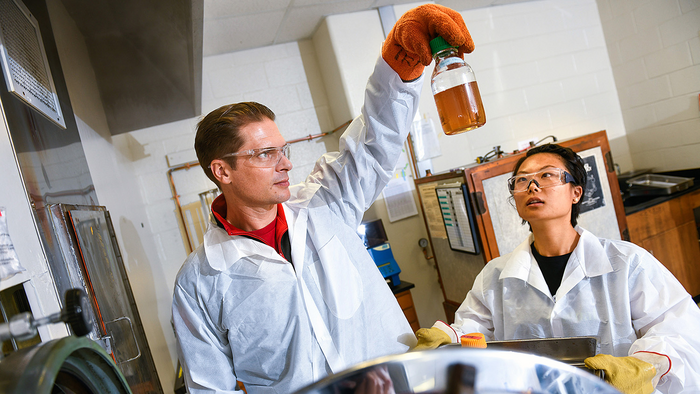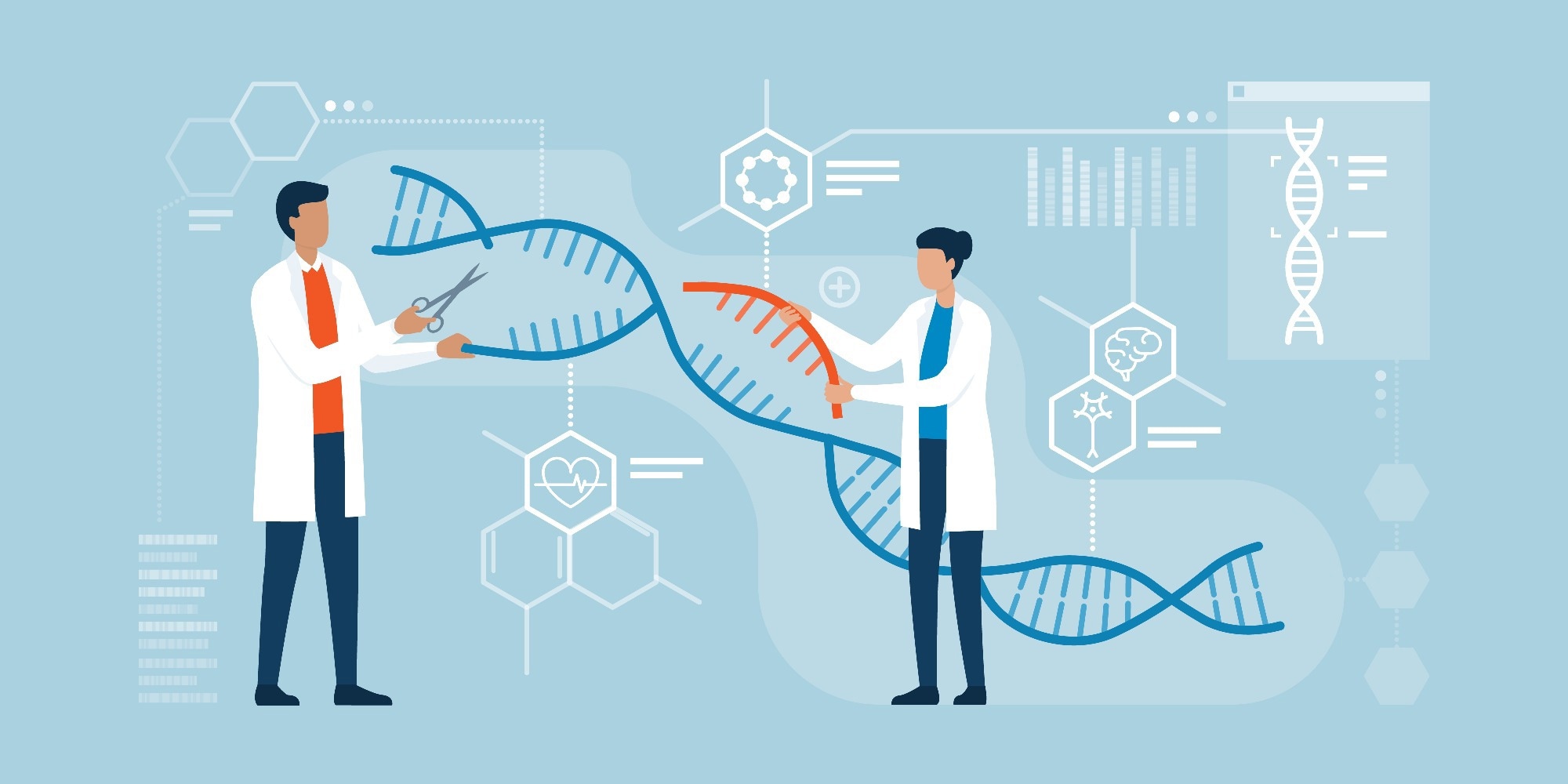My name is Echo Pan. I am a Ph.D. student at NC state university, majoring in Functional Genomics. I joined Rodolphe’s lab back in 2017 after I received my BS in food science from the University of Wisconsin – Madison.
I have always wanted to learn more about probiotics and the human microbiome. I was fascinated that these tiny bacteria can have such drastic impacts on our health. I had only heard about CRISPR once in my microbial genetic class when I joined the lab and had no idea I would work with it for my graduate school research.
Our lab has always been at the frontier of probiotic research, particularly in Lactobacillus, the no. 1 bacterial genus used in commercial probiotics. We have applied our CRISPR expertise to manipulate the genomes of Lactobacillus to study their probiotic efficacy better. On the other hand, limited molecular tools have been developed for Bifidobacterium, which leaves a gap in understanding the underlying mechanisms of probiotic efficacy of Bifidobacterium. We wanted to leverage our expertise in both CRISPR and microbiology to help fill in this technical gap.

Image Credit:
What are probiotics, and why are they commonly used?
The FAO/WHO definition of a probiotic is “live microorganisms which when administered in adequate amounts confer a health benefit on the host”.
Probiotics are usually referred to as the “good bacteria”. You can find them in supplements and fermented foods such as yogurt and cheese. Sometimes doctors will recommend patients take probiotics when they are prescribed antibiotics. The idea is that antibiotics tend to wipe out your native microbiome (both good and bad bacteria), and probiotics can help restore the normal microbiome. Probiotics have been associated with a range of health benefits such as digestive health, immune health, infant health, brain health, etc.
Scientists have uncovered some underlying mechanisms for how these beneficial microorganisms confer health benefits to humans. For the most part, however, researchers are still trying to understand exactly how probiotics work.
Bifidobacterium, a gut bacterium commonly used to help maintain healthy microbiomes, was the subject of your latest research. Despite this being found in many probiotics, it is difficult to characterize. Why is this?
Unlike other genetically tractable bacteria, genomic engineering in Bifidobacterium is hindered by different factors, including a limited molecular biology toolbox, a refractory cell wall structure, an abundance of restriction and modification (R-M) systems, and a lack of a universal replicon that replicates in a wide range of Bifidobacterium species.
Altogether, these limiting factors hamper our ability to investigate and manipulate this important genus (the second most formulated genus in commercial probiotics after Lactobacillus), and novel molecular tools will enable the engineering of Bifidobacterium strains with enhanced probiotic efficacy and the development of biotherapeutic applications
In your latest research, you looked into the genetics behind Bifidobacterium. Can you tell us how you conducted your research and the genetic tools used?
In this paper, we repurposed the endogenous type I-G CRISPR-Cas system and adopted an exogenous CRISPR base editor for genome engineering in B. animalis subsp. lactis. We utilized a combination of different approaches, including genomics, transcriptomics, computational analysis, and TXTL in vitro testing, to characterize the endogenous CRISPR-Cas systems in Bifidobacterium, which was crucial for downstream genome engineering applications. We also characterized the epigenomes of these bacteria, which helped us understand how these very closely related strains differentiate from each other.

Image Credit: Marc Hall, NC State University
What did you discover about the bacterium?
Results in this paper highlighted the importance of combining genomics and epigenetics to democratize genetic engineering in recalcitrant bacteria such as Bifidobacterium. Despite sharing highly homogenous genomes, these strains express different epigenetic patterns, which contribute to the different levels of genetic accessibilities across strains.
We anticipate that the heterogenous epigenetic patterns could also contribute to different probiotic performance beyond just genetic accessibility. A better understanding of the effect of epigenome on probiotic efficacy is something we are interested in exploring. As we showed in the paper, establishing a genome editing platform would be crucial to the discovery.
What implications will your findings have for the field of microbiology and, in particular, probiotics?
The strategies established in this paper can be exploited and applied broadly to other important bacteria, including the human gut microbiome and microbiomes across environmental niches such as water (oceans, lakes) and soil (for Ag and beyond). Since Bifidobacterium is a relatively under-studied genus with limited tools for DNA delivery and genome manipulation, the approaches we used can facilitate and accelerate the deployment of molecular microbiology and genome editing in numerous important but under-investigated genera.
Besides re-sensitization to antibiotics, as demonstrated in the paper, the strategies we established in the paper open new opportunities for probiotic enhancement. For example, we can fine-tune the carbohydrate metabolism to enhance the utilization of HMOs in breast milk by Bifidobacterium, which is highly associated with a healthy infant microbiome. To control inflammation, we can also perform cell surface engineering to modulate the molecular interplay with host epithelial and immune cells. We can also develop live biotherapeutic products (LBPs), engineering probiotics as chassis to deliver either enzymes or small molecule therapeutics. There is a wide range of applications to decipher and enhance the genetic attributes that render bifidobacteria highly relevant for human health.
For your latest research, you used CRISPR-Cas. With this still being a relatively new gene-editing technology, how has this influenced microbiology research? Are you hopeful that with continued advancements in technology, discoveries within microbiology will continue to emerge?
In nature, CRISPR-Cas systems serve as the adaptive immune systems in bacteria again bacteriophage attacks (my PI Dr. Rodolphe Barrangou actually first reported this in 2007). CRISPR has been used in the fermentation industry to immunize starter culture against phages long before it was repurposed as a genome editing tool. Microbiology scientists also took advantage of the hypervariable CRISPR array sequences to differentiate bacteria strains that are over 99% identical in genomes. In this regard, CRISPR has influenced microbiology research long before it was ever used to edit human cells or plant cells.
Since the CRISPR-Cas9 system was introduced, scientists have used CRISPR-based genome editing tools to manipulate genomes across the tree of life, revolutionizing the field of genetics. Although CRISPR has been rapidly adopted for genome engineering in eukaryotes, its deployment in prokaryotes has lagged due to many intrinsic factors such as nuclease lethality. This is where our research comes in, and hopefully, take a small step to help fill in this massive gap. There is so much unknown regarding our microbiome. I am certain that more discoveries within microbiology will continue to emerge.

Image Credit: elenabsl/Shutterstock.com
One sector that has taken a keen interest in probiotics is the wellness industry. How has this industry influenced probiotic research?
Recent advances in microbiome research have elicited a new wave of enthusiasm for probiotic bacteria for human health applications. Our industry collaborator, IFF, one of the largest probiotic suppliers in the world, has also observed an increasing demand from their customers in probiotic supplemented products such as protein bars, drinks, snacks, etc.
On the one hand, this is great that the public is becoming more health conscious and educated to make informed decisions. Especially after COVID-19 started in 2020, there has been a spike in public interest in health and wellness-related products such as probiotics. On the other hand, not all probiotics are created equal.
Unfortunately, many commercial probiotic products do not match the correct taxonomic group listed on the ingredient list or fall short in the viable cell counts before the expiration dates. All these shortcomings will negatively influence the probiotic industry and public confidence in this market. Structured regulations and effective and affordable methods to formulate and test commercial probiotic products would be crucial for the probiotic industry in the long run.
Your research was supported by NC State and the North Carolina Agricultural Foundation, as well as being a collaborative effort between many researchers. How important are funding, support, and collaboration in making new discoveries?
I am beyond thankful for the opportunity to work with so many excellent colleagues and collaborators; they have been a tremendous support throughout this journey. The NC Ag Foundation has been very supportive of funding translational agricultural research such as the ones we have in the lab. Success in any modern scientific research these days heavily relies on receiving sufficient funding.
I am very grateful for my PI, Dr. Rodolphe Barrangou, who always ensures his students have secure funding. In the current atmosphere of scarce funding, one’s career in academia is often closely linked with his or her ability to obtain funding. As a Ph.D. student, it is such a relief that I can just focus on research and getting the experiments to work without worrying about how to pay for my next semester’s tuition.
What are the next steps for you and your research into probiotics?
This research has raised more questions, such as how we can better streamline the genome modification process and how the epigenome affects the functions of Bifidobacterium, all of which we are actively working on in the lab. In the meantime, we have continued to strengthen our collaborative relationship with our industrial sponsor and consult to help enhance their probiotic products.
Personally, I plan to graduate in the Spring of 2023 and start my career in the biotechnology industry. I want to leverage my expertise in genomics, microbiology, and molecular biology in industry projects. Whether developing human biotherapeutics or the next generation of probiotics, I will utilize my skills and knowledge to make a translational, positive impact on people’s lives.
Where can readers find more information?
Please read our paper here: https://doi.org/10.1073/pnas.2205068119
About Echo Pan
Echo Pan is a Ph.D student majoring in Functional Genomics at NC State University. She previously obtained her MS in food science from NC State University in 2019. She graduated from UW-Madison with a BS in food science in 2017. 
- Rockey FFAR fellow at the Foundation of Food and Agriculture Research (2020 – 2023 cohort).
- Vice president of Graduate Student Association at NC State – Academic affair (2022 – 2023)
- Recipient of the Amy and Todd Klaenhammer FBNS Graduate Award Endowment (2018)